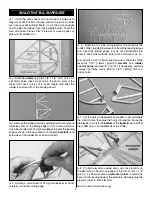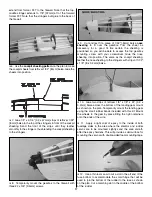
1. Even though the
Great Planes
Li’l Poke
is small, lightweight
and flies slowly, if it is not assembled and operated correctly it
could possibly cause injury to yourself or spectators and
damage property.
2. Build the plane according to the plans and instructions. Do
not alter or modify the model, as doing so may result in an
unsafe or unflyable model. In a few cases the instructions may
differ slightly from the photos. In those instances the plans and
written instructions should be considered as correct.
3. Take time to build straight and true.
4. Use an R/C radio system that is in first-class condition.
This Park Flyer requires micro servos, a micro receiver and
a micro speed control that is able to handle 5 amps.
5. You must properly install all R/C and other components so
that the model operates correctly on the ground and in the air.
6. You must test the operation of the model before
every
flight to insure that all equipment is operating, and that the
model has remained structurally sound. Be sure to check
connectors often and replace them if they show signs of
wear or fatigue.
Remember: Take your time and follow directions to end
up with a well-built model that is straight and true.
If you’re an inexperienced modeler, we recommend that
you get assistance from an experienced, knowledgeable
modeler to help you with assembly and your first flights
.
You’ll learn faster and avoid risking your model before you’re
truly ready to solo. Your local hobby shop has information
about flying clubs in your area whose membership includes
qualified instructors.
You can also contact the national Academy of Model
Aeronautics (AMA), which has more than 2,500 chartered
clubs across the country. Through any one of them,
instructor training programs and insured newcomer training
are available. Contact the AMA at the address or toll-free
phone number below.
Academy of Model Aeronautics
5151 East Memorial Drive
Muncie, IN 47302-9252
Tele. (800) 435-9262
Fax (765) 741-0057
or via the Internet at http://www.modelaircraft.org
Please inspect all parts carefully before starting to
build! If any parts are missing, broken or defective, or if
you have any questions about building or flying this
airplane, please call us at:
(217) 398-8970
or e-mail us at:
productsupport@greatplanes.com.
If you are calling for replacement parts, please
reference the part numbers and the kit identification
number (stamped on the end of the carton) and have
them ready when calling.
This is a partial list of items required to finish the Li’l Poke
that must be purchased separately. Order numbers are
provided in parentheses.
Radio Equipment
The Li’l Poke requires a micro receiver and two or three
micro servos (depending upon whether you will build the
Li’l Poke with or without ailerons). Futaba
®
S3103
(FUTM0037) or Hobbico
®
CS-5 (HCAM0090) micro
servos are suitable.
Speed Control
An electronic speed control with BEC (Battery Eliminator
Circuitry) is required to fly the Li’l Poke. The BEC allows
both the motor and the radio system to be powered by the
same battery (thus eliminating an additional battery
typically required to power the radio). The Great Planes
ElectriFly
™
C-5
Nano
™
High Frequency Electronic Speed
Control (GPMM2000) is recommended. If the complete
motor and gear drive system is purchased, the speed
control is included (refer to the
“Motor System”
section
that follows).
DECISIONS YOU MUST MAKE
NOTE
: We, as the kit manufacturer, provide you with a
top quality kit and great instructions, but ultimately the
quality of your finished model depends on how
you
build
it; therefore, we cannot in any way guarantee the
performance of your completed model, and no
representations are expressed or implied as to the
performance or safety of your completed model.
PROTECT YOUR MODEL,YOURSELF
& OTHERS...FOLLOW THESE
IMPORTANT SAFETY PRECAUTIONS
3




































